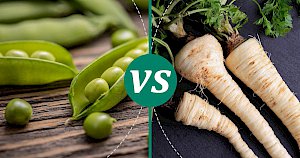Parsnips vs Peas: Calories & Nutrition Showdown


Parsnips vs Peas
Nutrition Facts
Parsnips
Serving size:
change
Amount Per Serving:
Serving size:
change
one parsnips (160g)cup (134g)half cup (67g)
5g10g15g20g30g40g50g60g80g100g120g140g160g180g200g220g250g300g350g400g450g500g600g700g800g900g1000g
1oz2oz3oz4oz5oz6oz7oz8oz10oz12oz15oz20oz25oz30oz35oz40oz50oz
5g10g15g20g30g40g50g60g80g100g120g140g160g180g200g220g250g300g350g400g450g500g600g700g800g900g1000g
1oz2oz3oz4oz5oz6oz7oz8oz10oz12oz15oz20oz25oz30oz35oz40oz50oz
Amount Per Serving:
Calories
% Daily Value
Total Fat g
0%
Cholesterol mg
0%
Sodium mg
0%
Total Carbohydrates g
0%
Dietary Fiber g
0%
Protein g
0%
Vitaminium C mg
0%
Calcium mg
0%
Iron mg
0%
Potassium mg
0%
Glycemic Index: 95
* The % Daily Value (DV) shows how much a nutrient in one serving of food contributes to your total daily diet. A 2000-calorie daily intake is used as a general guideline for nutrition advice.
Peas
Serving size:
change
Amount Per Serving:
Serving size:
change
one peas (5g)handful (60g)tablespoon (15g)cup (160g)half cup (80g)
5g10g15g20g30g40g50g60g80g100g120g140g160g180g200g220g250g300g350g400g450g500g600g700g800g900g1000g
1oz2oz3oz4oz5oz6oz7oz8oz10oz12oz15oz20oz25oz30oz35oz40oz50oz
5g10g15g20g30g40g50g60g80g100g120g140g160g180g200g220g250g300g350g400g450g500g600g700g800g900g1000g
1oz2oz3oz4oz5oz6oz7oz8oz10oz12oz15oz20oz25oz30oz35oz40oz50oz
Amount Per Serving:
Calories
% Daily Value
Total Fat g
0%
Saturated Fat g
0%
Cholesterol mg
0%
Sodium mg
0%
Total Carbohydrates g
0%
Dietary Fiber g
0%
Sugars g
Protein g
0%
Vitaminium C mg
0%
Calcium mg
0%
Iron mg
0%
Potassium mg
0%
* The % Daily Value (DV) shows how much a nutrient in one serving of food contributes to your total daily diet. A 2000-calorie daily intake is used as a general guideline for nutrition advice.
Parsnips vs Peas 100g Compare
| per 100g | Parsnips | Peas |
|---|---|---|
| Calories | 75 | 81 |
| Carbohydrates | 17.99 g | 14.45 g |
| Fat | 0.3 g | 0.4 g |
| Dietary fiber | 4.9 g | 5.7 g |
| Protein | 1.2 g | 5.42 g |
| Calcium | 36 mg | 25 mg |
| Iron | 0.59 mg | 1.47 mg |
| Magnessium | 29 mg | 33 mg |
| Potassium | 375 mg | 244 mg |
| Sodium | 10 mg | 5 mg |
| Vitaminium B1 (Thiamine) | 0.09 mg | 0.266 mg |
| Vitaminium B2 (riboflavin) | 0.05 mg | 0.132 mg |
| Vitaminium B3 (Niacin) | 0.7 mg | 2.09 mg |
| Vitaminium B5 | 0.6 mg | 0.104 mg |
| Vitaminium B6 | 0.9 mg | 0.169 mg |
| Vitaminium B9 (Folic acid) | 67 mg | 0.065 mg |
| Vitaminium C | 17 mg | 40 mg |
| Vitaminium K | 22.5 µg | 0.025 µg |
Discover the Nutritional Battle: Parsnips vs Peas
Parsnips and peas, two staples in many kitchens around the globe, come with their own set of interesting facts and nutritional benefits. Parsnips, with their sweet, earthy flavor, have been a winter favorite since Roman times. They are not just a root vegetable to be roasted alongside your Sunday dinner; they are packed with nutrients and have been used historically for their medicinal properties. On the other hand, peas, with their bright green hue and sweet taste, signal the arrival of spring in many cultures. They are one of the oldest cultivated vegetables, with evidence of cultivation dating back thousands of years. Beyond their use in culinary dishes, peas have been associated with various health benefits, making them more than just a side dish.Nutritional Content: A Closer Look
When comparing parsnips and peas, their nutritional content reveals some interesting contrasts and similarities that might help you decide which to include in your meal planning based on your dietary needs. - **Calories**: Parsnips contain slightly fewer calories than peas, with 75 calories per 100 grams compared to peas' 81 calories. This makes both vegetables a low-calorie option for those monitoring their calorie intake. - **Carbohydrates and Fiber**: Parsnips have a higher carbohydrate content at 17.99 grams per 100 grams, whereas peas have 14.45 grams. However, both are excellent sources of dietary fiber, essential for digestive health, with peas slightly edging out parsnips at 5.1 grams of fiber compared to 4.9 grams. - **Protein**: Peas are a superior source of protein, offering 5.42 grams per 100 grams, which is significantly higher than the 1.2 grams found in parsnips. This makes peas an excellent choice for vegetarians and vegans looking to boost their protein intake. - **Vitamins and Minerals**: Both vegetables are rich in vitamins and minerals, but they shine in different areas. Parsnips provide a good dose of vitamin C, potassium, and magnesium, while peas offer higher amounts of vitamin A, iron, and zinc.Health Benefits Galore
Beyond the numbers, the health benefits of both parsnips and peas are vast. Parsnips are a great source of antioxidants and may support heart health due to their high potassium content. Peas, with their higher protein and vitamin A content, can support eye health and provide essential nutrients for muscle repair and growth.Which One Should You Choose?
Choosing between parsnips and peas ultimately depends on your nutritional needs and taste preferences. If you're looking for a lower-calorie option that's high in carbohydrates and fiber, parsnips might be the way to go. However, if you need a protein boost and want to increase your intake of iron and vitamin A, peas could be a better choice.Conclusion
Both parsnips and peas offer unique nutritional profiles and health benefits, making them excellent additions to a balanced diet. Whether you prefer the sweet, earthy flavor of parsnips or the bright, fresh taste of peas, incorporating these vegetables into your meals can contribute to a healthier, more varied diet. Remember, the key to good nutrition is variety, so why not enjoy both?Parsnips 100g
75kcalCalories source
- 91% CARBS.
- 6% PROTEIN
- 3% FAT
Peas 100g
81kcalCalories source
- 70% CARBS
- 26% PROTEIN
- 4% FAT
Compares of parsnips
- Parsnips vs Asparagus
- Parsnips vs Bamboo Shoots
- Parsnips vs Beetroot
- Parsnips vs Butternut Squash
- Parsnips vs Carrot
- Parsnips vs Cassava
- see all compares of parsnips
Marcin Piotrowicz
calories-info.com creator
Healthy diet and healthy lifestyle promoter
Add comment